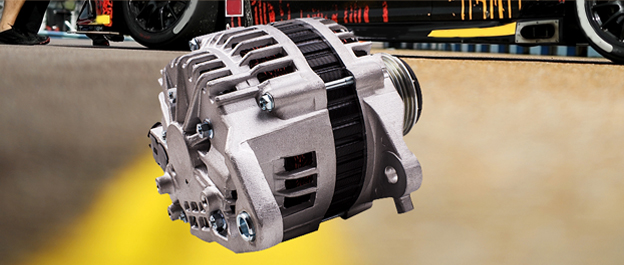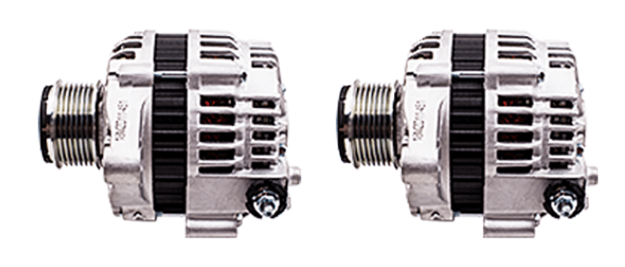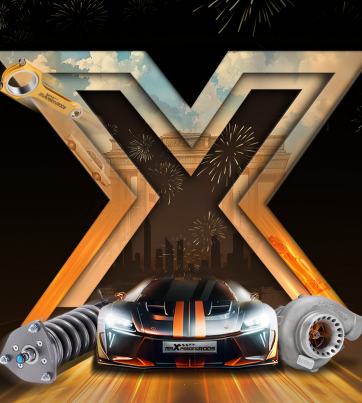Buying an alternator for your car can sometimes be a daunting and confusing task. At maxpeedingrods.com, it is our mission to make that task as an easy and painless as possible. This Buyer's Guide is designed to answer any questions you may have during your search for the right alternator for your car, and how to buy an alternator on our website.
What is an alternator?
The alternator in your car is a kind of mini electrical generator, which converts mechanical energy into electrical energy through a process known as alternating current. Without an alternator, the engine in your car would have no spark, your headlights no light, and your heater no way to keep you comfortable in the winter.
How the alternator on a car works?
Although many people assume that a car's battery powers all those things, the truth is that the battery
only does one thing other than keeping the electronics on when the engine is off: It starts the engine.
And only for a limited time. Once the engine fires, the alternator takes over and provides the juice.
Automobile engines run on air, fuel, and spark. While the battery supplies the electricity needed
for that initial spark, it only has enough power to get the car a few miles down the road, and that's
where the alternator comes in—it continually charges the car battery while the car is in motion while
also simultaneously operating all the electronic components of the vehicle. This means that while the
voltage of most car batteries is 12 volts, an alternator will typically output anywhere between 13 and
a half and 15 volts of electricity.
The alternator is comprised of a voltage regulator an three main components:
The stator, rotor, and diode. When the battery initially powers the car, the alternator belt, or V-belt,
spins the pulley on the alternator, causing the rotor inside the alternator to spin very quickly.
This rotor, which is basically a magnet or group of magnets, is situated inside a nest of copper
wires, which are called the stator.
The process whereby electricity is generated by spinning magnets
at incredibly fast speeds along a set of copper wires is called electromagnetism. The electricity
harnessed this way is conducted through the copper wires to a diode, which changes the electricity
from AC to DC, the current that the car battery uses.
The next step happens within the voltage
regulator—a built-in component on modern alternators—which is basically a gatekeeper that will
shut off the flow of power to the battery if the voltage goes above a certain level, usually 14
and a half volts, which keeps the battery from getting overcharged and burning out. As the car battery
is drained,current is allowed to flow back into it from the alternator, and the cycle goes on and on.
How to buy an alternator?
Selecting an alternator is never an easy thing unless you get to know these things nicely.
You can find your alternator by entering your vehicle's year, make and model, if for any reason you
cannot, you can find the best alternator for your vehicle by its Original Equipment Manufacturer (OEM)
number. The OEM part number can be found directly on the part itself. You can also call a dealership
with your VIN, and they will provide you with the OEM part number. You can contact one of our car
specialists at https://www.maxpeedingrods.com/ for further assistance on how to buy an alternator.
Why buy alternator at MaXpeedingRods?
MaXpeedingRods has been engaged in the research of overseas racing products and culture for
decades. If you are looking for alternator, you have landed at the right place. On the basis of
your vehicle make and model, you can choose from a plethora of automotive maintenance and
accessories. MaXpeedingRods offers a seamless online shopping experience and the streamlined
e-commerce interface makes it easy for you to find just the alternator you want.
MaXpeedingRods offers a variety of alternator with high quality.

What are the symptoms of a damaged or failing alternator?
The alternator supplies power to a vehicle's electrical components like the headlights. The alternator tends to fail gradually, and its warning signs can signify future breakdown long before it occurs. Diagnosing a problematic alternator early can save you from a world of trouble. Avoid ignoring the tell-tale signs, and get the problem fixed before you're stuck with an inoperable vehicle. Here we have explained some of the prominent symptoms and causes of worn-out alternators.
1. Difficulty Starting/Runs RoughIt requires a good deal of energy to crank the car's motor, and if a battery is not replenishing its power properly due to a faulty alternator, it will become drained and ineffective. You will hear a clicking noise while attempting to start the car, and the engine will have difficulty turning over. The initial course of action is to check your battery, be sure to check your alternator for problems, as well.
2. Degrading Performance of Electrical ComponentsThis warning sign is less obvious, but will progress in frequency. Over time, it will become evident that the alternator needs attention. Electrical components in the car will slowly start showing signs of failure: the headlights and dashboard lights will dim or the power windows will roll slower than usual. Eventually, these electrical components will cease to operate completely.
3. Growling or Whining NoiseThe alternator is driven by a belt in conjunction with the crankshaft pulley. The alternator pulley typically spins about two times faster than the crankshaft pulley to produce the necessary power for the vehicle at lower engine speeds, especially while idling. If the pulley is not in correct alignment with the belt, or if the bearings are won out, the alternator will make a growling noise. Be sure to perform a visual preventative check of the belt for cracking, excessive wear and other age-related issues.
4. Smell of Burning RubberThe scent of burning rubber or scorched wires sometimes indicate an alternator failure. Friction between a misaligned belt and the pulley will emit a smell of burning rubber. The burning wire smell can be caused by an overheated alternator.
5. Warning LightWhen your alternator does not perform up to its usual standard, the ALT or GEN light in your automobile's instrument panel will light up. If the electrical components of your vehicle do not seem to have their original potential, it is recommended that you check your alternator along with them.
Causes of a Bad Alternator
• One of the most common problems of a faulty alternator is a loosened belt.
• The diodes of the
alternator can go bad, failing to transmit the required voltage.
• The bearings on which the
alternator rotates can also be at fault and hinder the alternator from providing an optimal
performance.
• If there is any problem in the field voltage received by the alternator, it will not
function up to its optimum potential.
• Allow the engine to run and remove the negative cable of your vehicle's battery. If you notice the
automobile stalling, the problem is with the alternator. Otherwise, the problem lies with the
battery.
• Start your vehicle and have someone check the headlights. With the vehicle in “park”
mode, press the accelerator pedal. If the headlights dim in intensity or turn off altogether, the
problem is with the alternator. If not, the alternator is probably doing its job fine.

How to install an alternator in a car?
If it's about time to replace your car's alternator, you do not have to spend a lot by bringing your car to a shop. This guide should just be a supplement to the steps of installing a car alternator, depending on car brand and make. One important thing to do is to make sure your car's engine is cool enough to work with or you can burn yourself. Cover your car's fender to protect your paint job. Take note that if you cannot locate the alternator, reach the attachment bolts or free the nuts, stop and let a professional technician handle the job. As soon as you've figured out your alternator's location in your car, note how it is attached to you engine. There should be two points where the alternator is bolted to the engine, one which allows the alternator to swivel or swing in order to vary the tension on the V-belt. The other is usually a curved bracket with a long slotted hole in it that limits the amount of swivel and locks the alternator in place. With either socket wrench or a combination wrench, make sure you are able to reach for the bolts. In many cases you must use two wrenches, one on each side of the bolt in order to loosen it. It is beneficial to have another running vehicle close by. Ideally, you should remove the old alternator and V-belt from your vehicle and take them to the parts counter. This way, you can ensure that the replacements match perfectly.
Step1 : Disconnect the Negative Terminal of the Vehicle's BatteryIf you don't do this, some of the wires that run to the back of the alternator can short out if they touch the car body or engine. Disconnecting the battery will protect you and the electrical circuits of the vehicle.
Step 2: Loosen the Two Bolts that Hold the AlternatorIf these bolts have nuts on the opposite side, you may have to use two wrenches on one or both of these bolts. Do not remove the bolts yet.
Step 3: Rotate the AlternatorOnce you have loosened the bolts, try to rotate the alternator to loosen the slack in the V-belt - rotate it towards the direction that the V-belt runs. Just move the alternator enough to remove the V-belt from the alternator pulley. If you are replacing the V-belt at this time, take the belt off the rest of the pulleys on the engine. This may take some patience and involve a couple of scratched knuckles. You may have to work the belt over the radiator fan and shroud.
Step 4: Remove the Electrical WiresSometimes they are held in place by plugs with wire retainers; some are held on with nuts and washers. Using the masking tape and marker pen, mark the location of each wire that you remove so that you install them in the same place on the replacement alternator. Make a diagram of the wire locations on the back of the alternator and write down the color of the wire or plug that goes to each location. Check that the replacement alternator has the same type and location of fittings for the wires. You may have to use the old nuts and washers on the replacement unit. If so, clean them and even give them a quick wipe with some fine sandpaper.
Step 5: Adjust the BoltsLoosen the bolts that hold the alternator in place and remove them. Remove the alternator and set it aside. Take the replacement alternator and, if not already done, feed the bolts into place within the alternator housing. Position the alternator so that you can start to feed the bolts into the holes on the two engine brackets. Loosely place the nuts and washers on the back of the bolts. Make sure that you position the loosely held alternator so that it won't swing down and hit your knuckles!
Step 6: Install the BeltInstall the new V-belt on the engine pulleys first (and on any other engine accessory that it drives) and finally, on the alternator pulley. If the new V-belt is not the right size you can temporarily re-use the old belt. You can visit the parts counter again to get the correct size, and install a new V-belt at a later time.
Step 7: Position the AlternatorNow you need to position the alternator in the correct place and begin to get the right tension V-belt before you tighten the bolts that hold the alternator in place. This can be frustrating, particularly if you are working alone, but there is a way to simplify the job. First, hand-tighten the bolt/nut that holds the alternator to the engine (you still need to rotate the alternator to the correct position on the slotted bracket). Then rotate the alternator until it is holding the V-belt in place with no obvious slack. Now take a pair of vise grips and adjust the jaws so that they can tighten on the slotted bracket. Position the vise grips on the slotted bracket just behind the "ear" on the alternator housing. In other words, let the vise grips be your extra set of hands holding the alternator against the V-belt in the proper position. In effect, you are using the vise grips as a "stop" on the slotted bracket.
Step 8: Move the Vise GripBy just moving the vise grip slightly you can now add the right tension to the V-belt. First, as noted above, make sure that there is no discernible slack in the V-belt. Then pull the alternator about 1/2 to 3/4 inch further in order to pull the V-belt tighter (or, stated another way, apply about 20 pounds of force against the belt). With the alternator now held in this new position, reposition the vise grips on the slotted bracket to hold the alternator in place. At this point, you can take your time and tighten all the bolts that hold the alternator in place.
Step 9: Remove the Vise GripsRemove the vise grips and replace all of the electrical wires on the back of the alternator. Use your wiring diagram as a reference. Re-connect the battery negative terminal.
Step 10: Test the EngineTaking all appropriate safety precautions, start the engine. First, ensure that the ignition warning light in the instrument panel goes out after the engine has been started. Then listen to the belt. If you hear any belt squeal, the belt is too loose. Shut off the engine and try to further tighten the alternator on the slotted bracket. Be careful not to over-tension the belt. Too much pressure on the engine accessories can ruin the bearings of the water pump or alternator in a relatively short time.







